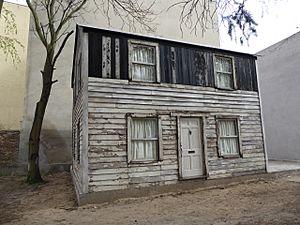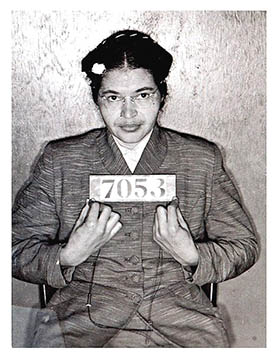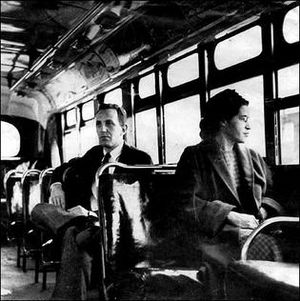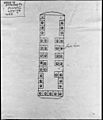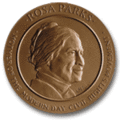Rosa Parks facts for kids
Quick facts for kids
Rosa Parks
|
|
|---|---|
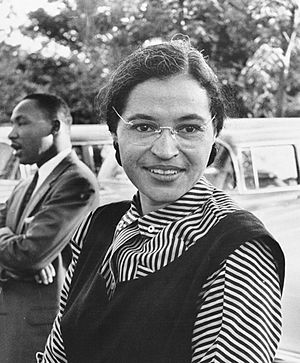
Rosa Parks in 1955, with Martin Luther King Jr. in the background
|
|
| Born |
Rosa Louise McCauley
February 4, 1913 |
| Died | October 24, 2005 (aged 92) |
| Resting place | Woodlawn Cemetery, Detroit, Michigan, U.S. |
| Occupation | Civil rights activist |
| Known for | Montgomery bus boycott |
| Movement | Civil Rights Movement |
| Spouse(s) |
Raymond Parks
(m. 1932; died 1977) |
| Signature | |
Rosa Louise McCauley Parks (February 4, 1913 – October 24, 2005) was an African-American civil rights activist. She has been called "the mother of the modern-day American civil rights movement" and "the mother of the freedom movement." She was a member of the local chapter of National Association for the Advancement of Colored People (NAACP).
Parks is best known for what she did in her hometown of Montgomery, Alabama, on December 1, 1955. While she sat in a seat in the middle of the bus behind the 10 front seats that were saved for white passengers, the bus driver told her to move to the back of the bus so a white passenger could take the seat toward the middle of the bus. During this time, when the seats reserved for white people on a bus were full, black people were told to get up from their seats. Parks refused to move. Like so many others, she was tired of being treated as a lower-class person because of her skin color.
Rosa was arrested. This led to the Montgomery bus boycott. The boycott lasted 381 days, and it caused a change in the law. After that, black people were able to sit wherever they wanted to on a bus. Her refusal to let others treat her differently was an important symbol in the campaign against racial segregation.
Contents
Early Years
Rosa Parks was born in Tuskegee, Alabama, on February 4, 1913. Her parents were James and Leona McCauley. She was mainly of African ancestry. One of her great-grandfathers was Scotch-Irish and lived in Charleston, South Carolina, as an indentured servant.
Rosa's father left home to find work when she was 2 years old. Her mother taught school in another town. Rosa and her brother Sylvester were raised by their grandparents.
Rosa started school in 1919 when she was 6 years old. At that time, schools were segregated. There were schools for black children and schools for white children. Later, Parks remembered how buses took white students to their school, but black students had to walk to theirs:
I'd see the bus pass every day... But to me, that was a way of life; we had no choice but to accept what was the custom. The bus was among the first ways I realized there was a black world and a white world.
In 1924, she went to the Montgomery Industrial School for Girls in Montgomery, Alabama. After 5 years, she left school and went to work in a shirt factory. She also took care of her grandmother.
In 1932, Rosa married Raymond Parks, a barber from Montgomery. Rosa worked many jobs, ranging from domestic worker to hospital aide. At her husband's urging, she finished her high school studies in 1933.
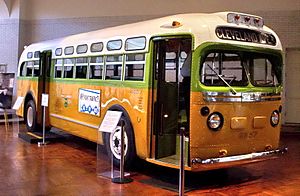
On December 1, 1955, Parks got onto a city bus to go home after work. She paid her 10¢ and sat down in the first row of seats behind the painted line on the floor that marked the beginning of the "colored" section. After several stops, more white passengers got on the bus and filled the first 10 seats that were saved for white passengers. The bus driver ordered Parks and three other black people to give up their seats so the rest of the white people could sit down closer to the front of the bus. The other three black people moved to the back of the bus, but Parks slid over to the window. She said she was following the law by sitting in the right section of the bus.
The driver stopped the bus and called the police. Two police officers arrested Parks and took her to jail for violating Alabama's bus laws.
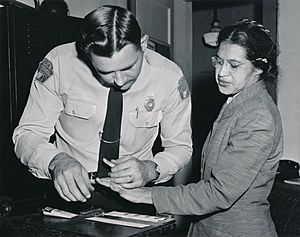
Her mother called upon Edgar Nixon to bail her out. Nixon was the president of the local NAACP chapter. Rosa was a member of that chapter and Nixon's secretary. Nixon knew the danger Parks was in and immediately arranged her bail.
The local NAACP had been looking for a test case to challenge the bus segregation laws. Parks was a respected working woman. She was well-spoken, and her case would be a good way to challenge the law. It was decided that on December 5, the day that Rosa was scheduled to appear in court, a boycott of all the buses in Montgomery would be held.
The word was spread throughout the black community of the intended bus boycott. Black ministers told their congregations to support the boycott. On Monday, December 5th, Rosa Parks appeared in court and black passengers stayed off the Montgomery buses. The streets of Montgomery were filled with black people walking. That same morning, all Montgomery buses were assigned two motorcycle policemen to guard against any black gangs scaring passengers. There were no black gangs. The black community simply cooperated with the boycott. The buses remained empty all day. White passengers who feared trouble stayed off the buses as well.
In addition to the charge of violating the bus laws, Parks was also charged with disorderly conduct. Her trial was quick, only lasting about 30 minutes. The court found her guilty of all charges and fined her $14. The boycott continued.
Browder v. Gayle
Parks appealed her conviction. Her attorney, Fred Gray, and others in the NAACP brought an appeal named Browder v. Gayle. The appeals court ruled on June 19, 1956, in favor of the black citizens of Montgomery. The city, however, asked the Supreme Court to review the decision.
On September 13, 1956, the Supreme Court of the United States upheld the appeals court's ruling. After 381 days, the bus boycott ended. Black citizens of Montgomery could ride the buses and sit where they chose. Rosa Parks rode the bus again on December 21, 1956. This time it was an integrated bus. Ironically, she had the same bus driver who had her arrested the year before. In an interview, Parks said, "He didn't react (pause) and neither did I."
After the Boycott
After the Montgomery Bus Boycott, Parks went through many difficulties. She lost her job at the department store. Her husband was forced to quit his job.
In 1957, Parks and her husband left Montgomery for Hampton, Virginia, to find work. In Hampton, Parks found a job as a hostess in an inn at Hampton Institute, a historically black college.
Later, Parks and her husband moved to Detroit, Michigan. Parks continued to work as an activist. For years, she worked for United States Congressman John Conyers. After that, she worked as an activist against apartheid in South Africa. She also opened a center in Detroit that advised black youth about careers and job opportunities.

In 1999, President Bill Clinton awarded Parks a Congressional Gold Medal. This is the United States' highest honor (most important award) for civilians.
Rosa and her husband Raymond never had children. They spent their entire lives dedicated to each other, their respective careers, and civil rights activities.
Parks died on October 24, 2005, at her home in Detroit due to dementia. On October 30, her casket lay in honor in the United States Capitol. This is a great honor for people in the United States.
Rosa Parks is still considered a heroine of the black community. While she didn't do it alone, her actions sparked a fire that led to great changes.
Rosa Parks quotes
- “You must never be fearful about what you are doing when it is right.”
- “Each person must live their life as a model for others.”
- “I knew someone had to take the first step and I made up my mind not to move.”
- “Differences of race, nationality, or religion should not be used to deny any human being citizenship rights or privileges.”
- "I believe there is only one race – the human race."
- "The only tired I was, was tired of giving in."
Interesting Facts about Rosa Parks
- Rosa earned her high school diploma at a time when less than 7% of African Americans earned them.
- Rosa Parks was an activist for civil rights 12 years before she refused to give up her seat to a white passenger.
- The bus driver, James F. Blake, had driven away without her on purpose 12 years before she refused to give up her seat.
- Rosa Parks was not the first person to refuse to give up her seat on a Montgomery public bus. 15-year-old Claudette Colvin was the first to be arrested for refusing to give up her seat and Parks was involved in raising funds for Colvin's defense.
- Parks was not physically tired when she refused to give up her seat. She explained that she was "tired of giving in."
- Rosa Parks became the secretary of the Alabama State Conference of the NAACP.
- Rosa Parks and her husband, along with her mother, moved to Detroit.
- Bus seats were left empty in New York City, Washington, D.C., and other cities on the 50th anniversary of Rosa's arrest to honor her and the results of her civil disobedience.
Questions kids ask about Rosa Parks
What is Rosa Parks famous for?
When she refused to give her bus seat to a white man, she helped initiate the Civil Rights Movement in the United States.
How is Rosa Parks a hero?
She was brave to peacefully refuse to leave her seat. She knew it wasn't right for her to have to give up her seat to a white passenger, but she also knew she would probably be arrested.
What was Rosa Parks's job?
Rosa Parks worked as a seamstress. She worked at the Montgomery Fair department store and was going home from there on the day she was arrested.
Why did Rosa Parks not give up her seat?
She was tired of having to give up a seat for which she had paid. She believed she shouldn't have to move just because of her race.
Where is Rosa Parks buried?
Woodlawn Cemetery (Detroit, Michigan), United States.
What did the Montgomery bus boycott lead to?
The boycott led to the Supreme Court declaring that Montgomery's segregation laws on buses were unconstitutional.
What is Rosa Parks's full name?
Rosa Louise McCauley Parks.
Who did Rosa Parks marry?
Rosa married Raymond Parks, a barber, in 1932.
Images for kids
-
Rosa Parks statue by Eugene Daub (2013), in National Statuary Hall, United States Capitol
-
The Rosa Parks Congressional Gold Medal
-
Parks and U.S. President Bill Clinton
-
Rosa Parks Railway Station in Paris
See also
 In Spanish: Rosa Parks para niños
In Spanish: Rosa Parks para niños


